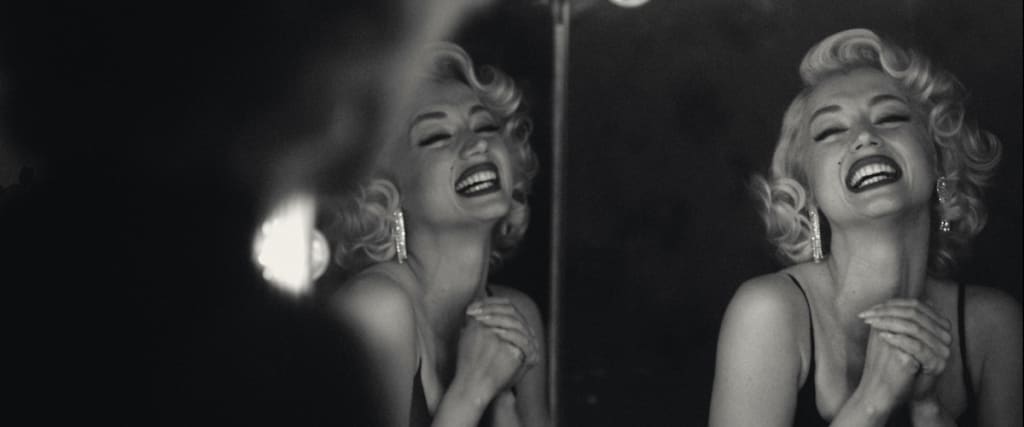
Norma Jeane Mortenson descends into Marilyn Monroe hell in this nightmarish biography film by Andrew Dominik. Blonde is intense and repulsive, terrible and mesmerizing, flat and layered. You won't find a more impressive portrayal of Marilyn Monroe's agony, but unfortunately the film is never more than that.
In my teenage room in my father's house, there was a framed black-and-white nude photo of Marilyn Monroe. It had been picked up by my father decades earlier and later passed on to me. So at least three people owned that print, and countless others around the world passed through their hands copies of that same photo. Is that Marilyn Monroe's legacy? An heirloom, a collector's item or an object of exchange passed down from generation to generation?
In Andrew Dominik's Blonde , this American icon's fetishization encounters the gruesome reality behind the scenes. How that printed image of Marilyn Monroe passed from hand to hand pales in comparison to what happened to the actual human being, is emphasized by this ruthless film, based on the "biographical fiction" from Joyce Carol Oates' novel of the same name. Monroe, played with the utmost devotion by Ana de Armas, is exchanged, exploited and carried away by a variety of men, from the studio boss and her husbands to acting colleagues in the film business. Even the American president takes control of her body and throws the puritan image of the United States out the window for good in a rape scene that is as layered as it is gruesome.
For almost three hours you witness the relentless exploitation of Norma Jeane Mortenson, the woman who is shaped into the monster Marilyn. She is the victim of the twentieth century: the icon of American superiority who had to suffer like a saint for it. There is no escape from that agony, just more layers of misery that the film wants to drag you through. In that sense, Blonde can be seen as the modern answer to Carl Theodor Dreyer's La passion de Joan of Arc (1929), but without the feminist catharsis. Richard Brody of The New Yorker compares Dominik's film to Mel Gibson's The Passion of the Christ(2004): he sees both as monotonous agony that mainly shows a perverse sadism on the part of the directors when they subject their main characters to the most gruesome events.
Indeed, Blonde is often gruesome, hideous, repugnant, painful, oppressive, alienating and unnerving. There are scenes in between that generate a lot of stress. Stress that you then have nowhere to lose, because the relentless film just keeps pounding. Blonde could therefore already count on a lot of criticism at the Venice Film Festival, where the film screened in the main competition . The film thinly recreates the traumas and horror from the life of Norma Jeane Mortenson and does nothing in return. Is this the fate of Marilyn Monroe, one wonders, that her agony is being reenacted and exploited for our spectacle even forty years after her death?
It is a valid criticism, and one that the film itself has no answer to. Joyce Carol Oates recently emphasized that Mortenson's real life was much more painful than what we see in the film, but that's not really what the critics are about. It's not about what happens to Norma Jean/Marilyn Monroe in this movie, but how the movie treats those events. In blondeis very explicitly chosen for the subjective world of the main character, which means that we never escape from the prism of her trauma. The funeral music of Nick Cave and Warren Ellis, the at times dreamy and at times nightmarish imagery of Chayse Irvin, the kaleidoscopic montage of Adam Robinson - everything revolves around Norma Jean's descent into her personal hell as Marilyn Monroe.
The film flows and lusts and circles around Ana de Armas, but it cannot escape that downward spiral. Any chance of escape (through her talents as an artist, loving character, radiant personality and inexhaustible work ethic) are also taken away from her. She is like Frankenstein's monster: created by someone else, left to her own devices and stripped of all freedom and autonomy. Marilyn Monroe is a tragic figure in Blonde . Nothing more, nothing less. Practically speaking, we're back to square one – the film is the latest in a seemingly endless series of images once again punishing, humiliating and exploiting Monroe.
Blonde is therefore not liberating , but the film does work as a Freudian commentary on the American id. It's a bit tricky, but maybe you should just forget about Marilyn Monroe when you watch this movie and think about how these layers of oppression have become part of our modern society. Dominik previously made The Assassination of Jesse James by the Coward Robert Ford (2007) and Killing Them Softly (2012), much more subtle deconstructions of violence and masculinity in America. Seen from that context is Blonde a film that is about the violence that men can exert, even on the back of perhaps the most famous woman on earth. It's a movie that uses women's agony to say something about men and a movie that uses Marilyn Monroe's symbol to say something about America. That is exactly what makes this film right and wrong, honest and false, layered and flat. There is no escape from these contradictions, just as Norma Jean can never escape Marilyn.






Comments
Halle Boid is not accepting comments at the moment
Want to show your support? Send them a one-off tip.